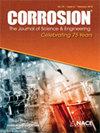抑制碳钢局部腐蚀扩展的恒电位研究
IF 1.1
4区 材料科学
Q4 MATERIALS SCIENCE, MULTIDISCIPLINARY
引用次数: 0
摘要
即使在均匀腐蚀率保持较低的情况下,碳钢管道中也会发生局部腐蚀,这是碳氢化合物生产和输送行业的一个主要问题。这些凹坑的传播是由抑制表面和活性凹坑之间的电流耦合引起的,可能会导致严重的后果,如经济损失、环境破坏、生产中断,甚至生命损失。为了更好地理解这一现象,本工作的重点是使用恒电位技术来评估局部腐蚀传播的趋势。在55°C和80°C的采出水条件(5 wt.%NaCl,pH 4.5,CO2饱和)下,使用主要基于咪唑啉的缓蚀剂进行实验。通过线性极化电阻和动电位极化测试获得基线结果。然后进行恒电位实验,以人工模拟在活性局部腐蚀的情况下可能存在的不同水平的电流耦合。结果表明,在一定的阳极电位下,增加抑制剂的用量是显著降低电流的必要条件。然而,在高电流水平下,进一步注射是不够的,这表明底物溶解可能会影响抑制剂的吸附。这项工作为抑制剂的作用和阻止碳钢局部腐蚀传播的重要因素提供了见解。为了充分理解这一复杂现象,有必要进行进一步的研究,例如设计一个合适的零电阻电流表设置。结果表明,恒电位法可以快速简便地获得电化学信息,提高对局部腐蚀传播的理解。本文章由计算机程序翻译,如有差异,请以英文原文为准。
Inhibition of Localized Corrosion Propagation on Carbon Steel: a Potentiostatic Study
The occurrence of localized corrosion in carbon steel pipelines, even when the uniform corrosion rate remains low, is a major concern in the hydrocarbon production and transmission industry. The propagation of these pits, caused by the galvanic coupling between the inhibited surface and the active pit, can lead to serious consequences such as financial loss, environmental damage, production interruption, and even loss of life. To better understand this phenomenon, this work focuses on using the potentiostatic technique to evaluate the tendency of localized corrosion propagation. The experiments were conducted using a primarily imidazolinium-based corrosion inhibitor in produced water conditions (5 wt.% NaCl, pH 4.5, CO2-saturated) at 55°C and 80°C. The baseline results were obtained through linear polarization resistance and potentiodynamic polarization tests. The potentiostatic experiments were then conducted to artificially simulate different levels of galvanic coupling that could exist in case of active localized corrosion. The results showed that, at certain anodic potentials, increased inhibitor dosage was necessary to significantly decrease the current. However, at high current levels, further injections were insufficient, indicating that substrate dissolution may affect the adsorption of the inhibitor. This work provides insights into the role of inhibitors and important factors in stopping the propagation of localized corrosion of carbon steel. Further research, such as designing a proper zero-resistance ammeter setup, will be necessary to fully understand this complex phenomenon. The results show that the potentiostatic methodology can be a rapid and easy alternative to obtain electrochemical information and improve understanding of localized corrosion propagation.
求助全文
通过发布文献求助,成功后即可免费获取论文全文。
去求助
来源期刊

Corrosion
MATERIALS SCIENCE, MULTIDISCIPLINARY-METALLURGY & METALLURGICAL ENGINEERING
CiteScore
2.80
自引率
12.50%
发文量
97
审稿时长
3 months
期刊介绍:
CORROSION is the premier research journal featuring peer-reviewed technical articles from the world’s top researchers and provides a permanent record of progress in the science and technology of corrosion prevention and control. The scope of the journal includes the latest developments in areas of corrosion metallurgy, mechanisms, predictors, cracking (sulfide stress, stress corrosion, hydrogen-induced), passivation, and CO2 corrosion.
70+ years and over 7,100 peer-reviewed articles with advances in corrosion science and engineering have been published in CORROSION. The journal publishes seven article types – original articles, invited critical reviews, technical notes, corrosion communications fast-tracked for rapid publication, special research topic issues, research letters of yearly annual conference student poster sessions, and scientific investigations of field corrosion processes. CORROSION, the Journal of Science and Engineering, serves as an important communication platform for academics, researchers, technical libraries, and universities.
Articles considered for CORROSION should have significant permanent value and should accomplish at least one of the following objectives:
• Contribute awareness of corrosion phenomena,
• Advance understanding of fundamental process, and/or
• Further the knowledge of techniques and practices used to reduce corrosion.
 求助内容:
求助内容: 应助结果提醒方式:
应助结果提醒方式:


